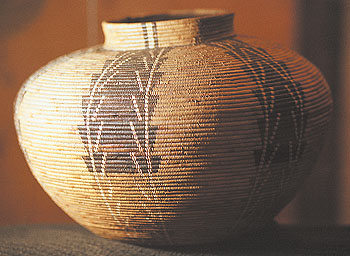|
|
Sinforosa Fustero, Newhall's Tataviam Basket Maker.
By David Desmond
| October 2000.
|
Sitting in a display case at the Saugus Train Station Museum in Heritage Junction are two baskets made by Sinforosa, the last known Tataviam Indian basket maker. The two baskets were donated by Irene (Ruiz) McKibben (1898-1995), the daughter of Martin Ruiz and stepdaughter of Nick Rivera, who were business owners in Newhall's early years.
I interviewed Irene in 1986, and she recalled that the baskets were given to her mother by Sinforosa, who was known as the last Tataviam basket maker. Irene did not have much more information on Sinforosa other than she lived in Newhall when Irene was young. Irene's stepfather, Nick Rivera, was a well-known saloon keeper in Newhall. I had acquired a merchant trade token embossed on the front, "N.H. Rivera, Newhall, CAL" and on the back, "Good for 10 cents in trade." Irene recalled that Nick Rivera also had a saloon in Randburg, a Mojave desert mining camp, and vividly remembered the dance hall girls in their brightly colored clothes. I also had found another merchant trade token embossed "Martin R. Ruiz Saloon" and "Good for one drink," but Irene emphatically denied that her father ever owned a saloon. She said her father was a butcher and died in Newhall in 1900 while digging a well. She added that she had the same argument with the late SCV historian A.B. Perkins in the 1950s, so the subject was dropped. Irene McKibben was a great source of local history and her donation of Sinforosa's baskets were a great legacy to the Santa Clarita Valley. Most of the generation who knew Sinforosa were now gone. Thanks to Tom Frew IV and Gladys Laney, I was able to find someone still living who remembered Sinforosa. Mrs. Lyda (Cooke) Marquez, who was born 95 years ago in Tapia Canyon (near present day Castaic) still remembers, "Sinforosa lived across the street from my parents on Walnut Street. She lived in a tent."
Lyda's parents were Indians with some Tataviam blood lines. Lyda went on to recall, "Sinforosa was very old at this time and was no longer making baskets. She was a very small woman. One day they took down her tent, so she must have died. Later I saw two men digging where the tent was. I was told by my parents they were looking for money that she may have buried." Lyda thinks they took the tent down in the early 1910s. Dr. John Johnson at the Santa Barbara Museum of Natural History agrees. He co-authored a paper with David Earle of the Lancaster Museum on Sinforosa Fustero's genealogy. He believes Sinforosa died in a Tehachapi sanitarium in 1912. The two baskets sitting quietly in the Saugus Train Station are a testament of a people, the Tataviam — a small material reminder of its last basket maker, Sinforosa Fustero. Although we cannot rewrite history and erase the rapid development of the West which diminished the Tataviams and thousands of other Indians, we can still honor the memory of Sinforosa Fustero through her exquisite baskets.
Webmaster's note: Sinforosa Fustero was the mother of Juan José Fustero, thought to be the last full-blooded Tataviam. Archaeologists have not verified that these baskets were made by Sinforosa; some (such as the aforementioned Dr. John Johnson) think it more likely that they came into her possession.
David Desmond, of Palmdale, is a member of the Santa Clarita Valley Historical Society. ©2000 Santa Clarita Valley Historical Society. |
• Tataviam Ethnohistory Johnson & Earle 1990 • The Indians of Mission San Fernando (Johnson 1997) 
Sinforosa Fustero ~1910
|
The site owner makes no assertions as to ownership of any original copyrights to digitized images. However, these images are intended for Personal or Research use only. Any other kind of use, including but not limited to commercial or scholarly publication in any medium or format, public exhibition, or use online or in a web site, may be subject to additional restrictions including but not limited to the copyrights held by parties other than the site owner. USERS ARE SOLELY RESPONSIBLE for determining the existence of such rights and for obtaining any permissions and/or paying associated fees necessary for the proposed use.





